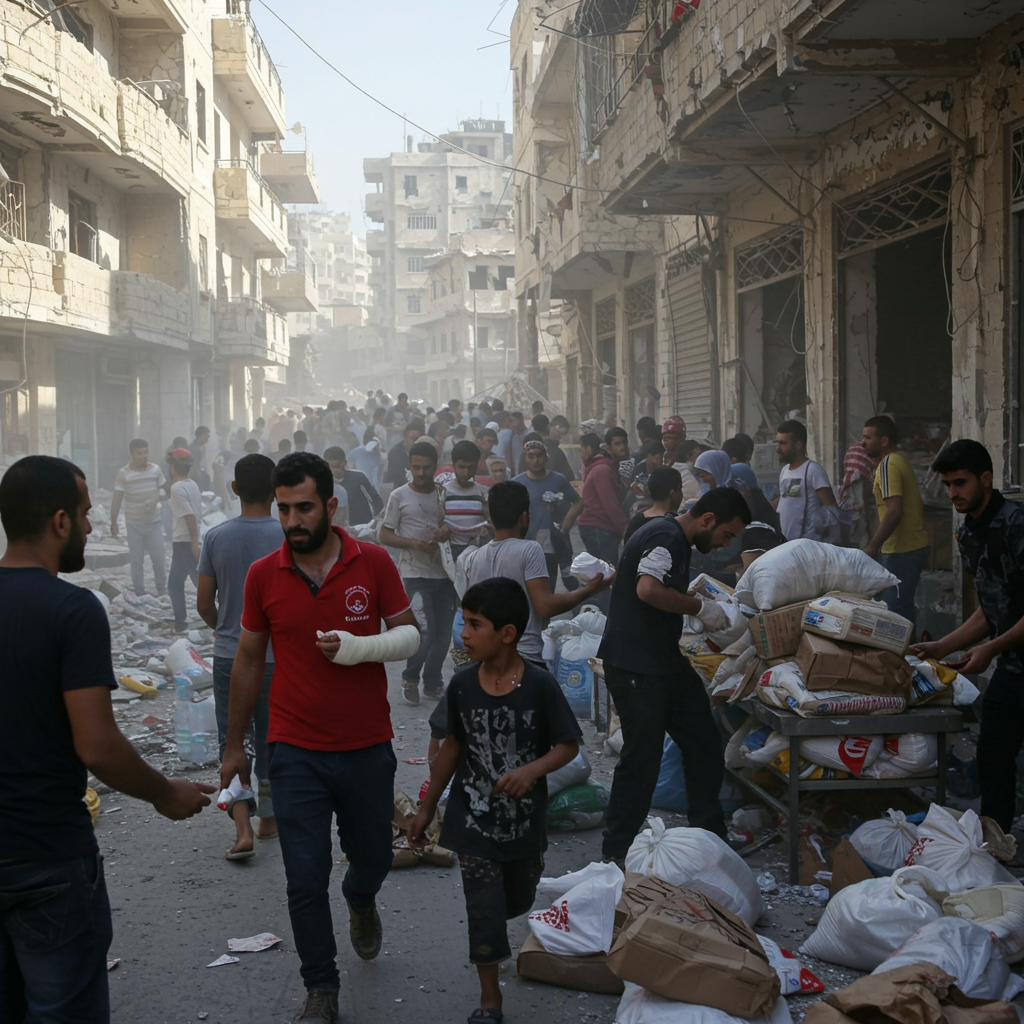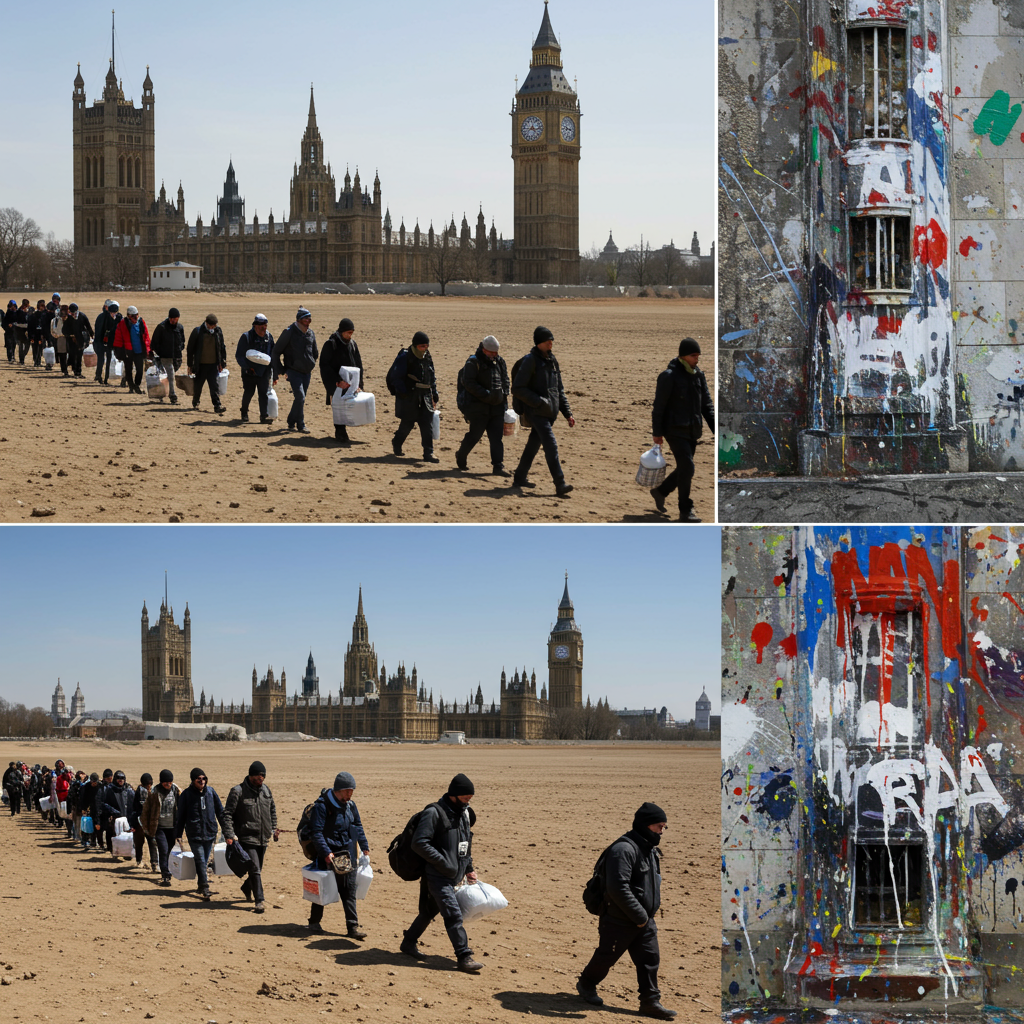Tragedy continues to strike in Gaza as violence intersects with the desperate struggle for survival. Two American aid workers were injured this week at a food distribution site. Simultaneously, dozens of Palestinians have been killed. these deaths occurred both in <a href="https://news.quantosei.com/2025/07/05/hamas-prepared-to-negotiate-over-implementation-of-ceasefire-proposal/” title=”Gaza Ceasefire: Hamas Signals Breakthrough, Ready Talks”>israeli airstrikes and while people attempted to secure essential food aid. The incidents highlight the extreme dangers faced by civilians and humanitarians alike. They unfold against the backdrop of fragile ceasefire negotiations. Efforts led by the U.S. aim to halt the nearly 21-month-old conflict.
Aid Workers Injured at Distribution Point
An attack targeted a food distribution site in Khan Younis, southern Gaza, on Saturday. Two American aid workers sustained injuries during this incident. They are affiliated with the Gaza Humanitarian Foundation (GHF). This organization receives support from both the U.S. and Israel. The GHF claimed assailants threw grenades at their site. They later shared a photo of explosive fragments. The foundation attributed the attack to Hamas militants. However, they did not immediately provide independent evidence to support this claim. The GHF reported the injuries were not life-threatening. Both workers received prompt medical attention.
Israeli Prime Minister Benjamin Netanyahu issued a statement following the attack. He wished the aid workers a “speedy recovery.” Netanyahu praised the GHF and former U.S. President Trump for their contributions to aid efforts. He condemned the incident as revealing “the brutality of Hamas.” The Prime Minister called on the United Nations to stop opposing the GHF’s operations. He urged the UN to collaborate to ensure the foundation can safely continue its work for Gaza residents.
Deadly Airstrikes Rock Gaza
Separate from the attack on the aid site, Israeli airstrikes caused significant casualties across the territory. Hospital officials in Gaza reported that strikes on Saturday killed 14 Palestinians. One particularly devastating strike hit tents in the Muwasi area. This is a crowded coastal zone often used for shelter. Seven people died there, including a Palestinian doctor and his three young children. Nasser Hospital in Khan Younis confirmed these fatalities.
Further strikes occurred in other southern Gaza locations. Four people were killed in the town of Bani Suheila. Three others died in three separate strikes within Khan Younis itself. The Israeli army did not offer immediate comment on these specific strikes.
Palestinians Killed Seeking Food Aid
The humanitarian crisis in Gaza has reached critical levels. Many residents face severe hunger and rely entirely on external aid. This desperation has led to deadly outcomes as people attempt to access food. Gaza hospital officials reported that at least 10 Palestinians were killed while seeking food aid this week. Eight of these deaths occurred near a GHF distribution site in the southern city of Rafah. Another individual was killed near a different GHF location in Rafah. It remains unclear exactly how close the victims were to the distribution points.
The Gaza Humanitarian Foundation disputed claims that these killings happened near their sites. The GHF has previously stated that no one has been shot at their facilities. Their sites are reportedly guarded by private contractors. Access to these points requires passing through Israeli military positions located hundreds of meters away. However, earlier reports from CBS News indicated a GHF contractor acknowledged a colleague had fired into a crowd at one aid site.
The Israeli military did not provide immediate comment on these incidents. However, they have stated in the past that warning shots are used for crowd control. They maintain troops only fire directly at individuals when they perceive a threat. In a separate incident not linked to the GHF, one Palestinian was killed waiting for international aid trucks in eastern Khan Younis.
Aid distribution in Gaza is fraught with danger and logistical challenges. Crowds of desperate Palestinians often gather around incoming aid trucks. Sometimes, they attempt to unload or even loot contents before the trucks reach designated destinations. These aid convoys must navigate areas under Israeli military control, adding complexity and risk to the process.
Deepening Humanitarian Crisis and Aid Controversy
Gaza’s population of over 2 million faces an dire humanitarian situation. The war has devastated infrastructure and crippled local food production. Nearly everyone now depends on external assistance. However, aid delivery faces significant hurdles. The United Nations and other international organizations report severe access restrictions. They describe the aid flow as merely a “trickle” compared to the overwhelming need. Bottlenecks at the Kerem Shalom crossing, the primary entry point Israel permits for aid, are a major issue. UN teams report that coordination requests for movements, including collecting supplies or delivering essential services like water and fuel, are frequently rejected by Israeli authorities.
The Gaza Humanitarian Foundation itself is a source of considerable controversy. It is structured as a U.S.- and Israeli-backed initiative. Critics argue it is intended to bypass established UN aid channels. The GHF operates distribution points surrounded by Israeli troops. The U.N. and other humanitarian groups have strongly criticized this system. They argue it potentially allows Israel to use food as a weapon. They also contend it violates humanitarian principles and is inefficient. These organizations further dispute Israel’s claims that Hamas diverts UN-delivered aid. Hamas, in turn, has urged Palestinians not to cooperate with the GHF.
Palestinians attempting to reach GHF distribution sites face extreme risks. According to the Hamas-run Gaza Health Ministry and witness accounts, Israeli troops frequently open fire towards crowds on roads leading to these points. This has reportedly resulted in hundreds killed and wounded over recent months. The UN Human Rights office has documented a pattern of dozens of Palestinians killed while seeking aid around GHF sites, sometimes involving helicopters, naval vessels, tanks, and ground troops. The UN High Commissioner for Human Rights has condemned these attacks. He described them as potential war crimes. He called for independent investigations. The UN stresses that the “wilful impediment of access to food” is a grave breach of international law.
Beyond food, the aid blockade impacts every aspect of life. Hospitals face critical shortages of medicine, equipment, and even basic supplies like pain killers and antibiotics. Doctors are forced to perform procedures without adequate anesthesia. Widespread malnutrition is rampant, especially among children. Aid workers report seeing babies severely underweight, fed only sweetened water because families cannot afford milk. Disease is spreading rapidly due to overcrowding, lack of clean water, and poor sanitation in displacement camps. Vaccine deliveries have stopped, leaving the population vulnerable to preventable illnesses. This crisis is forcing families into desperate measures. Child labor, early marriage, and family separation are reportedly on the rise.
Ceasefire Hopes Amid Continued Violence
The latest wave of violence occurs as diplomatic efforts to secure a ceasefire appear to be gaining some momentum. U.S.-led negotiations have been ongoing for months. Late on Friday, Hamas reportedly gave a “positive” response to the most recent U.S. proposal. This plan suggested a 60-day truce. However, Hamas indicated that further discussions on the details of implementation are necessary.
Hamas’s core demands for a lasting agreement remain consistent. They seek guarantees that any initial truce will lead to a permanent end to the war. They also demand the complete withdrawal of Israeli troops from Gaza. Furthermore, Hamas has insisted that aid delivery should be managed exclusively by the U.N. and its partners. They explicitly called for the GHF to be shut down.
Reports from Israeli media suggest Israel is expected to send a delegation to Qatar soon. These talks would focus on a potential deal involving hostages held by Hamas and a ceasefire. Former President Trump has been actively pushing for an agreement. He is scheduled to host Prime Minister Netanyahu at the White House next week for discussions. Netanyahu has maintained his position that the war will not end until all hostages are released and the military and governing capabilities of Hamas are permanently destroyed.
The immense human cost of the conflict weighs heavily on Gaza’s residents. Many displaced Palestinians voiced their desperation for peace. “We cannot bear it anymore,” one man told CBS Saturday Morning, describing repeated displacement. “We pray there will be a ceasefire, regardless of the demands. Just agree and let the people breathe.”
Background of the Conflict
The current devastating conflict began on October 7, 2023. Hamas launched a surprise attack on Israel. The assault resulted in the deaths of approximately 1,200 people in Israel. Around 250 others were taken hostage. Israel responded with a massive military offensive in Gaza. This offensive has caused widespread destruction. According to the Hamas-run Gaza Health Ministry, over 57,000 Palestinians have been killed. The offensive has displaced nearly Gaza’s entire population of 2 million people. It has pushed many residents to the brink of famine.
The Gaza Health Ministry compiles casualty figures. While it does not distinguish between civilians and combatants, its statistics are widely cited. The U.N. and other international organizations consider these figures the most reliable available data on the war’s casualties.
Frequently Asked Questions
What is the Gaza Humanitarian Foundation (GHF) and why is it controversial?
The GHF is an aid initiative supported by the U.S. and Israel. It distributes food from sites within Gaza, often surrounded by Israeli troops. It was reportedly created to bypass traditional aid channels managed by the U.N. and other international bodies. The GHF is controversial because the U.N. and aid groups argue it allows Israel control over aid distribution, potentially violating humanitarian principles. They also claim it is ineffective and that aid seekers approaching GHF sites have faced frequent gunfire from Israeli forces.
Where did the recent deadly incidents involving aid seekers occur in Gaza?
Recent reports indicate multiple incidents where Palestinians were killed while attempting to get food aid. Gaza hospital officials reported deaths near GHF distribution sites in Rafah. Another incident involved a Palestinian killed while waiting for aid trucks in eastern Khan Younis, though this was not linked to GHF operations. The UN human rights office has also reported many deaths around southern Gaza aid hubs, often involving fire from Israeli forces.
How is the lack of aid impacting daily life and health in Gaza?
The scarcity of aid is causing a severe humanitarian crisis. Widespread malnutrition is prevalent, especially in children. Hospitals face critical shortages of medicine, medical supplies, and equipment, making it difficult to treat the injured and sick. Disease is spreading rapidly due to poor sanitation and overcrowding in displacement camps. The lack of essentials forces families into desperate measures, including child labor and early marriage, compounding the human suffering.
The ongoing conflict and its profound impact on aid delivery have created an unprecedented humanitarian catastrophe in Gaza. The safety of aid workers and the ability of civilians to access essential supplies remain critical concerns. International efforts continue to push for a ceasefire, hoping to alleviate the suffering and create conditions for effective humanitarian assistance to reach those in desperate need.



